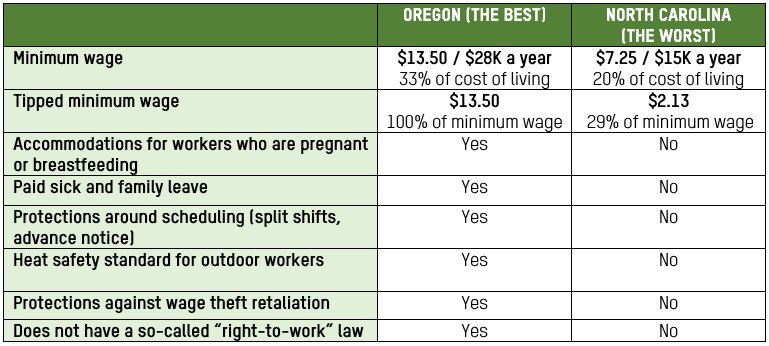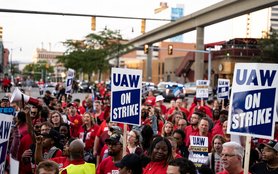As Congress has been largely deadlocked over recent years, it’s fallen to the states to make the most important changes to labor laws and policies. The result? A crazy patchwork quilt of laws that vary wildly from one state to the next, and pour fuel on the fire of widening inequality in the US.
When we talk about systemic inequality in the US, let’s not forget one of the most intractable: state boundaries draw lines around fundamental rights, conditions, and protections for citizens, and they establish very different realities.
When Oxfam published the first edition of the Best States to Work Index (BSWI) in 2018, we were surprised to see the wide range of labor laws across the country. At that point, the top and bottom states sat right next to each other: Washington, DC was #1, and Virginia was #51. The minimum wage alone was almost double in DC what it was in Virginia ($13.25 vs $7.25), and protections and rights to organize were similarly diverse.
Five editions later, in 2022, the disparities are still there – but they’ve gotten even deeper. The top states continue to make progressive changes to labor laws to help working families stay afloat and healthy; while the bottom states remain obdurate, refusing to take simple steps like rising the minimum wage in the face of historic inflation. (A few states have taken action, with important new laws, and this has improved the landscape for working families – and bumped them up in the index. Virginia has jumped from the bottom to #22 in 2022.)
The result is a growing gap among states, with the better states getting stronger, and the worse states trapping workers in poverty, with dangerous conditions and no rights to organize freely.
It needs to be said that the best states are getting better because of a circle of virtue: where workers and advocates are empowered to organize and demand changes, state legislatures respond (in the best states); where workers are underpaid and ignored, it’s less likely that the legislature will act.
The overwhelming need is for Congress to establish federal standards that support working families in every state: raise the wage, pass the PRO Act, mandate paid leave, and more. As long as Congress fails to act, working families in the worse states will, unfairly, face terrible odds on staying afloat and getting ahead.
The gaps between the best and worst states are huge
If you live and work in one of the best states, you’re doing better on all three dimensions of the BSWI. You make dramatically better wages (even accounting for cost of living), have much more robust protections at work, and have rights to organize and bargain collectively.
The table captures some of the data points in the top state (Oregon) vs the bottom state (North Carolina).

These are not just policies and data points; they are living laws that determine a family’s income, conditions in the workplace, and rights to unionize.
And the trend is only accelerating
On the one hand, the “good” states have kept up a steady pace of improvements; while the “bad” states have refused to take positive steps forward for working families.
Wages
- As of 2022, 30 states (plus DC and Puerto Rico) have minimum wages above the federal minimum. Since 2018, most have continued to bump the wage as costs of living have gone up. For example, the minimum in DC has gone from $13.25 to $16.10.
- Of the 22 states that did not mandate a wage higher than the federal in 2018, 20 states still do not; they have not raised the wage floor in 13 years (since the federal wage was raised to $7.25 in 2009). In that time, all costs of living have escalated rapidly. Just since the onset of the COVID-19 pandemic, the cost of food alone has risen by over a third. This means that real wages in these 20 states are drastically lower in 2022 than they were in 2018.
Protections
- Oregon, California, and Washington passed heat standards that mandate protections for outdoor workers. (Two states established more limited protections: Minnesota passed a heat standard for indoor workers, Colorado has a standard for farmworkers only.)
- Since 2018, several states have passed paid sick leave; and a few passed paid family leave, allowing workers to take paid time off for a variety of family situations (such as starting or expanding a family via birth or adoption, caring for family with serious health condition).
- Nevada passed new legislation stopping private sector employers from requesting past salary information from their new hires, allowing for greater pay equity.
- Few of the states at the bottom made any moves to mandate paid leave (sick, maternity, family); to accommodate workers who are pregnant or breastfeeding; to protect against abuses in scheduling.
Rights to organize
- Many of the states at the top of index have consistently scored 100 on this dimension, offering robust protections around rights to organize and bargain collectively.
- At the same time, four states in the bottom ten score zero on this dimension: North Carolina, Georgia, Texas, and South Carolina; and they have not budged.
What can Congress do?
We need federal standards that protect ALL workers, no matter where they live. Briefly, Congress should:
- Raise Wages: The federal minimum wage has not been raised from $7.25 an hour since 2009. Both at the state and the federal levels, Oxfam calls on policymakers to increase wages: abolish tipped wages, end minimum wage exclusions of certain workers, and lift the minimum wage. The Raise the Wage Act would accomplish all this at the federal level. At the state level, 30 states have succeeded in raising their minimum wage, but not one single state raised it enough to cover basic costs of living for a family.
- Strengthen Worker Protections: There is a great need for stronger worker protections at the state and federal levels, including paid family and medical leave, stronger equal pay laws, pregnancy accommodations, and protections for domestic workers. There are several bills Congress can pass to establish federal paid leave standards, including the FAMILY Act, the Healthy Families Act, and the Building an Economy for Families Act. The Pregnant Workers Fairness Act would prohibit discrimination for “qualified employees affected by pregnancy, childbirth, or related medical conditions” and require reasonable accommodations. The Domestic Workers Bill of Rights extends pay and leave rights to domestic workers while mandating health and safety precautions, including language around fair and fixed scheduling.
- Protect Rights to Organize: The federal government must protect the rights of workers to build power collectively. At the state level, the prevalence of “right-to-work” laws demonstrates the systematic approach to undermining worker power; the federal government has one crucial piece of legislation to pass: The Protecting Rights to Organize (‘PRO’) Act.
Explore the 2022 interactive map to see how the states score

See the 2022 map for all workers
See the 2022 map of Best States for Working Women
Check out the full history of the BSWI: Previous editions
- See the 2021 map
- See the 2021 map of Best States for Working Women
- See the 2020 special edition: Best and Worst States to Work in America – During COVID-19
- 2020 regular edition
- 2019 edition
- 2018 edition
Full data in this spreadsheet



